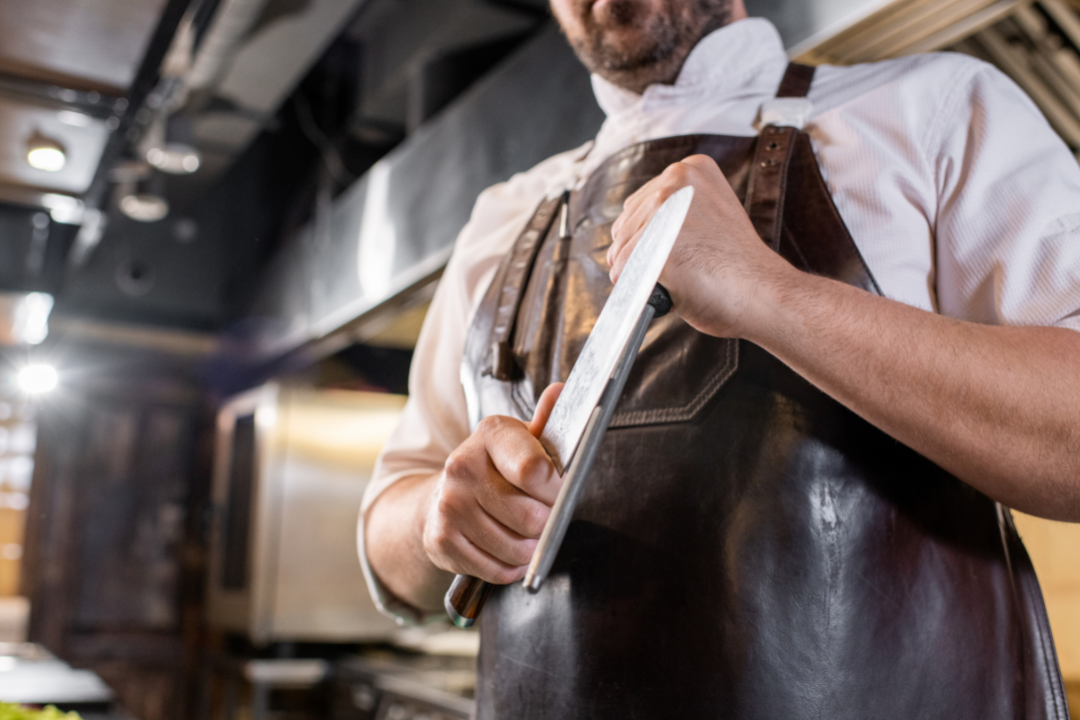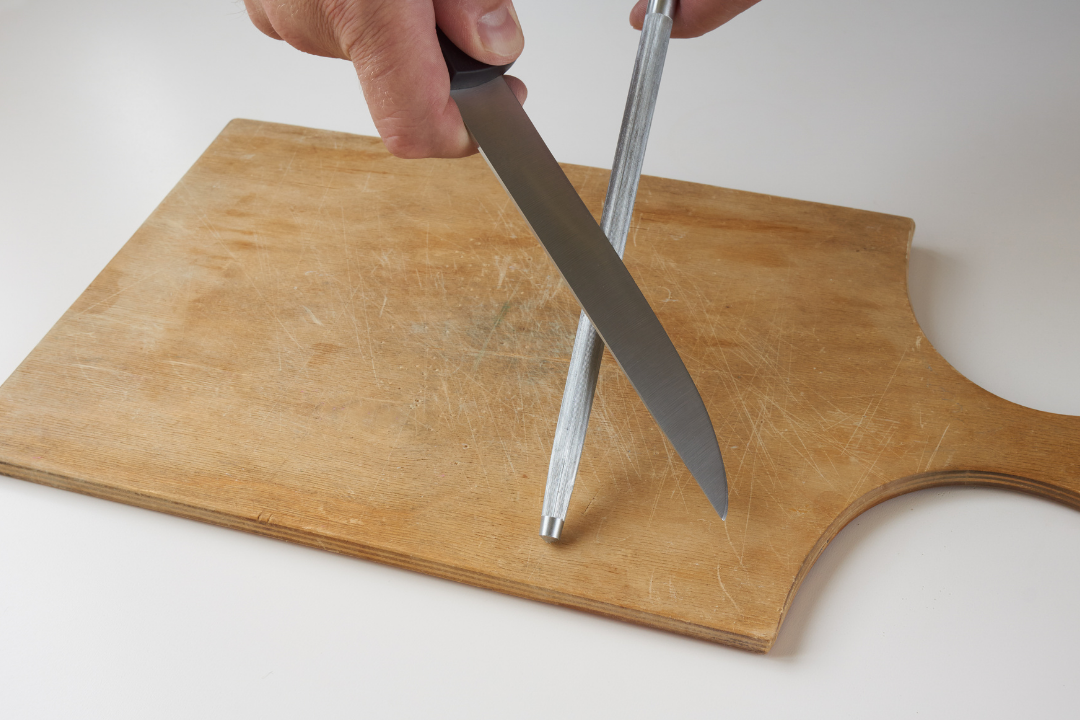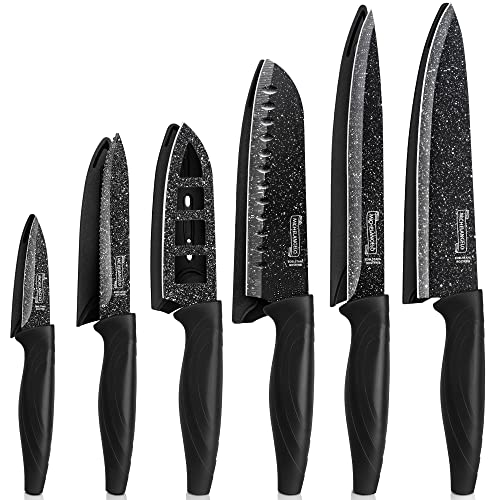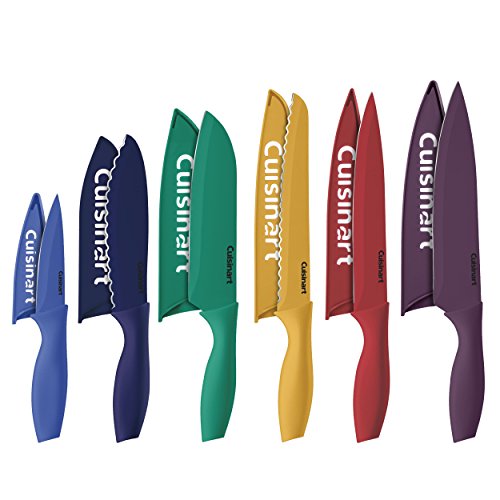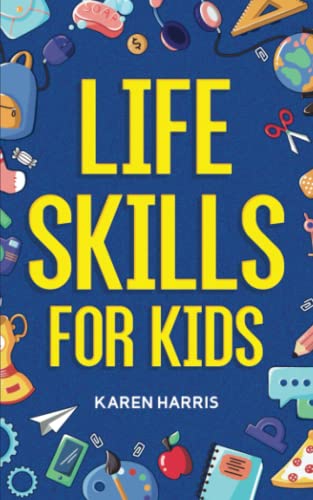How To Sharpen A Knife With A Rod?
Don’t be intimidated by the idea of sharpening your knives. The process is easy and produces a clean edge that will make slicing and dicing foods easier! This blog post will teach you how to use a rod to sharpen your knives. It’s not as hard as it sounds, so read on for more information.
Before we get started, please make sure you have these materials: knife-sharpening rod (also called a whetstone), two cups of water, dish towel or rag. Make sure the sink has some running water too! I also recommend wearing gloves for this task in case any small pieces break off during the sharpening process. If there are kids around who might want to help out with this task.
What is a honing rod?
What is a honing rod? A honing rod, sometimes called a sharpening rod, hone steel, boning knife, honing saw, or chef’s knife, is an adjustable steel rod having a diamond-tipped cross-section and an approximate lengthwise of nine or ten inches. They are usually flat, oval, or rounded at the cross-section and more than a foot long. The blade teeth are either sharpened or filed with a honing-rod. The teeth are positioned over a hard carbon block of carbon steel called a ferrous die. Most knives have a center ground diamond honed ferrous die.
Step one: The step one way to find out what is a honing rod is to put your finger on the blade and press down gently. The skin should move back and forth as the knife slips into the cutting edge. This is a test of whether or not your blade is ready for the next step. Remember, no matter what type of knife you use, you must hone it. Dull blades will not cut properly and will break or chip easier.
Step two: To test if the rod is the correct angle, hold the blade at an angle not more than half a radian from the horizontal. If the knife has an acute angle, which means that it is coming to the tip of the blade at an angle less than ninety degrees, it is a right angle. If it has a milder angle, it is left angle. If it is off by more than about twenty degrees, you need to hone it further.
Why would you want to sharpen a knife?
Why would you want to sharpen a knife? There are many reasons, actually. Some of them include security measures, knowing the correct technique for using a particular knife, and enhancing your appearance by getting rid of an unsightly scar. The decision all depends on you. If the thought of blood in your hands fills you with the appropriate fear that you may do something bad then you might want to get a professional knife sharpener.
There are many ways that professionals can help you. You can tell them what kind of knives you have, what brand of knife it is, and what time period you are interested in studying how to sharpen your knife. Within a few minutes, they will have determined what the best way to do this is for you. They will give you the information that you need, including where you can get the materials you need to perform the procedure at home. They will also make sure that you know everything there is to know about doing this so you don’t make any mistakes.
This can be a very quick process, as some people may only need to have their knives sharpened for a matter of minutes. Others will want to do it more slowly, using a good multiple blade sharpener. Either way, it should be a relatively painless process for you. Most times you only need to get out the sharpening stone and have it ready for your use. Then all you do is put the knife into the stone for the required amount of time and then take it out.
Another reason that people would like to get a professional sharpener is so that they can perform the procedure themselves. This is something that has been done for years so there are many ways that this can be done. If you have the time to spend, it isn’t too difficult to do this yourself. It might take you a little bit of time to do it as well, though. So if you just don’t have the time to invest or don’t think that you have the time to invest, then you can always go to a professional to get the job done right.
Knowing the benefits of a knife sharpener is going to help you decide if you are going to hire someone to do it for you want to do it yourself. Of course, if you already have a nice sharp knife and you are tired of having to clean it every once in a while, then the option of having the knife sharpened professionally is one that might appeal to you. This is especially true if you want to get a really high quality knife sharpener. There are some really expensive ones that can be expensive even when you compare them to a low-priced professional sharpener. However, if you really want a high quality knife sharpener and you are not that worried about how long the knife is going to last, then you might be best to sharpen it yourself using a knife sharpener kit. These kits come with many different blades so you will be able to sharpen your knife right in your own kitchen.
Another question to ask yourself when you are wondering, “Why would you want to sharpen a knife?” is if you are going to do it every time you use your knife. This means that you might want to find a way to sharpen your knife so that the blade will last longer and that you will have to sharpen the knife more often. It is probably not the best idea to sharpen your knife every time you want to use it. Instead, think about whether you need to sharpen it very often or not, and then make the decision as to whether you are going to hire a professional knife sharpener or you are going to buy a sharpener kit.
When should I hone my knives?
When should I hone my knives? This is one of the most common questions that is asked by many people when they are looking to buy a new set of knives. What is the best time to sharpen a knife? What type of things should I be doing to keep my knives sharp?
Sharpening a knife is something that you should do at least once a year or after every few months. Your best option is to have your knives professionally sharpened, and then store the extra blade in a safe place. When should I hone my knives? The answer to this question will depend on how often you use your knives.
If you are someone who uses their knives very often, you may want to get them sharpened professionally. However, if you only use your knives occasionally, then it is probably not necessary to have your knives professionally sharpened. Keep in mind that if you use your knife too much, the blade can eventually wear down to the point where it will not operate properly. For this reason, you will want to make sure that you keep your blades sharp so that you will be able to get the most use out of each knife that you own.
Another option when you want to know the best time to sharpen your knives is to decide which specific category your knives fall under. There are three main categories of knives: traditional pocket knives, ceremonial knives, and collectible knives. Each of these categories has specific happenings that are best performed for each type of knife.
For example, a pocket knife is designed to be used in an emergency situation. Because of this, it is important that you bring along extra blades with you whenever you go out. The best way to sharpen your knives is to use the finest quality of knife sharpener that is available. If you do not feel comfortable doing this on your own, then you should have someone do it for you.
The best time to sharpen your knives is while they are still hot from being used. To heat up the knife, place it in a pan of hot water for around five minutes. After the initial warm up has passed, you can begin to carefully sharpen it. Do not forget to let the blade cool before you begin cutting. If you forget to do this, the blade may become blunt or break when you attempt to cut it again. When you purchase your new pair of pocket knives, be sure to purchase one that falls into the correct category so that you will be able to get the best possible sharpening for each individual item.
Is Honing a Knife the Same as Sharpening?
When you buy a new knife, is honing a knife the same as sharpening? That depends on what kind of knife you’re talking about. Most of the time, if it’s a wood carving knife, it will not need to be sharpened with a knife sharpener. The reason for this is that wood carvings are done by hand, and all that really needs to be done is to polish the blade so that it looks nice.
Some other types of knives such as a serrated knife do need to be sharpened. These kinds of knives are similar to the carving knives. However, they usually need to have a professional do it instead of doing it yourself at home. There are several reasons why these kinds of knives need to have their edges honed. First of all, in order to get the edge to be flat and smooth, the knife must be perfectly straight. It’s impossible for a machine to do this for a knife with a flat edge.
Secondly, when the knife is put in a blade sharpening stone (or the stone is pushed into the knife), the edges will become much sharper. This means that the knife will need to be sharper than it was before. In some cases, the edge can be over 2% sharper. This is a significant difference in many cases.
Thirdly, when a knife is sharpened, it may need to go through an autoclave process. This process is made up of dipping the knife into hot water and then heating it up to over 500 degrees Fahrenheit. After it is dipped, the knife is placed in an autoclave machine and held under pressure. This causes the knife to get hot and then quickly cool down.
After this, it gets pushed back into the metal core of the knife. This allows the two edges to meet and bond more closely. This is why you don’t need to remove the knife edge from the core when performing a knife sharpening. You’ll only need to do that right before putting the blade back in.
These are just a few of the many reasons why people prefer a knife with a sharp edge over one that doesn’t. Many beginners to the world of knives sharpen their own knives. They use a manual tool, such as a pdw or a good bread knife, and hone it by placing pressure on the various ridges on the blade. Many professional chefs also sharpen their own knives after taking them to the chef shop to have them service the knives the correct way.
The Difference Between Sharpening and Honing
Sharpening vs. honing. These two may sound like they’re similar, but in truth, they’re very different. Both can cause damage to your knife’s finish if not performed correctly, so understanding what they are and how they affect your knives is vital to maintain the quality of the end product. Both may seem like they both lead to the same end result, which is just to increase the sharpness of the knife, but in fact they do different things. Below, you’ll learn the difference and introduce you to your different honing and sharpening options, including the most common sharpening tool used by professional chefs.
Basically, there are two types of knife sharpening: Regular sharpening and abrasive hone. Regular honing is what most knife makers recommend since it produces a very high level of carbon and other elements that will wear away at the surface of your knife’s blade. By using a regular honing process over again, you will produce a knife with worn layers, especially on the outside of the blade. An abrasive hone produces tiny scratches in your knives surface without causing any damage to the surface. This method may cause some slight changes in the appearance of your knives, but over time these small changes become undetectable.
The type of steel teeth you use also affects the performance of your blade. When sharpening a traditional chef knife, you will be using a specific compound, called honing steel, to create the tiny scratches on the surface of the blade. In comparison, with an electric sharpener, you’ll be using metal oxide or carbon steel teeth. With oxide steel teeth, they provide more surface area for the abrasive, making your final result takes longer to reach the desired level of sharpness.
The difference between honing and sharpening can also be determined by the angle of the blade. When sharpening a traditional chef knife, a flat-bladed knife sharpener will use the same and usually identical, methods as the electric sharpeners. It just so happens that the blade is actually being sharpened at an angle. The sharpening is taking place at the center of the blade, where the cutting edge meets the handle. Electric sharpeners use a different method, and it is almost always a two-stage process where the second stage is much faster than the first.
A knife sharpener’s biggest problem is maintaining an edge as you use it. Because of friction, every time you cut with a dull blade you are transferring that dullness from the knife to your food. This transfer causes the knife edge to dull quickly and requires more effort to correct. With gas and electric sharpeners, this is usually easy to address because all you need is a clean rag and water to clean off the blade. However, the knife sharpener in the kitchen needs to sharpen manually with a metal file, or in some cases a wood block or wooden chopstick.
The best time to perform the honing process is right after you have used the knife to eat meals, as the food and juices should already be soft. This allows you to catch any drips that may occur when you move the knife and create pressure on the blade. The best way to accomplish this is to press down on the knife handle firmly. Be sure to wipe your hand with water afterwards so you can avoid having the water absorbed into the handle. If you have an automatic sharpener, the manufacturer’s directions will tell you how long you should hold the button down before releasing it to avoid damaging the sharpener. For manual sharpeners, it is best to give it a few seconds to allow the blade to dull completely.
Most of the products available for sharpening knives offer the same benefits of regular honing, but with added advantages. Some of the best examples include the Knuckle Sandwich Chefset, which use diamond studded stones as well as special grooves for extra sharp edge performance; the Wusthof Classic Lite, which offer the benefits of regular and automatic sharpening without taking away from the blades flexibility; and the Santico Elite, which provide superlative cutting performance. While there are a few other brands with similar benefits, most manufacturers recognize the value in using specialized whetstones to perform the task.
When purchasing a sharpener, whether it is for your kitchen knives or for other purposes, you should keep in mind the difference between sharpening steel and hone points. You can use either to attain the same results, but professional chefs highly prefer using the hone point because it eliminates the need for extra care during and after use. Although the cost may be higher than sharpening steel, the advantages you receive make it the sensible decision for chefs who want to provide the highest level of quality and performance. For the average chef, it is usually the better choice, giving you the ability to perform your favorite task without worrying about damaging your investment.
How do you sharpen a knife with a rod?
It is easy to see the idea behind rod-shaped honing and sharpening tools. The blade should be run along the rod’s surface at the right angle to achieve the desired effect.
This is what you see on professional cooking shows. The chef whips their knife along the rod at lightning speed, then proceeds to dice 12 tomatoes at the same pace while bemoaning other cooks for being lazy. However, most of us don’t have enough practice to be able do this like that.
Vertical stroke is a safer and simpler method to hone your knife using a rod. Here’s how it works:
The rod tip should be held down against a non-slip countertop or wood cutting board. It should be held far enough away from your body so that it doesn’t slip and cause injury, but not too far to make it difficult to control.
With the blade edge down, place the heel of your knife blade against a rod’s upper portion. The knife’s tip should be slightly up.
To create a 15 degree angle between the knife’s flat and the rod, tilt the flat sideways. This angle can vary depending on the knife’s bevel angle.
You can slide the knife down and pull it towards you. The knife should reach the tip before it reaches the rod’s end. The angle should be maintained at the same 15 degrees all the way.
This motion should be repeated 4-5 times.
Repeat the process on the opposite side of your blade. You should only sharpen the one side of your knife if it is only beveled.
Before you use the knife, rinse it off.
You should honing your steel or ceramic rods (ceramic or stainless) every few days. This will prolong the knife’s life and make slicing much easier. You’ll only need to sharpen your knife once a year with actual rods.
Types of honing rods
Rods can be made from different materials, as mentioned earlier. They can all be used in the same way, but their purpose may differ.
Ceramic Sharpening Rod
Ceramic rods have a greater variety than other materials. Ceramic material is extremely hard. Ceramic material is very hard, which means it can resist bending but also has brittle properties.
This is a good thing because your rod will keep its straight surface for a long period of time. Its brittle nature also means that it is susceptible to breaking if dropped, making it useless.
Ceramic material can be slightly abrasive. Ceramic rods are designed to be used for honing purposes, but will wear only a small amount of your blade. You can still use the rod for honing, unless it is specifically advertised for its abrasive qualities. To prevent metal filings from becoming abrasives, rinse them off after use.
If you use ceramic rods a lot, they can wear down. They are often the most affordable option.
Knife Sharpening Steel Rod
The most popular and most durable of all these types of tools are steel rods. They are often part of knife sets, and almost always come with the smooth-surfaced honing type.
The steel honing rods can be straightened by using a harder steel than other knives. The rod will eventually lose some material, but this should not be a problem.
Important: Before you put your honing iron in the knife block/drawer, wash it with soapy water. Rust spots are not something anyone wants!
Diamond Rod Knife Sharpener
Diamond-dust-impregnated sharpening rods are different than most of their counterparts. These tools are sharpening tools, not honing. They shouldn’t be used more often than once a year.
Sharpening properly takes a little more precision than honing. Other methods, such as pull-through sharpeners, may be better for you if you aren’t sure how to maintain the correct angle. A rod sharpener such as this is a great way to speed up the process if you are skilled at it.
How to maintain the sharpness of your blade after using it?
People have different ways on how to maintain the sharpness of their blades. They do this through different methods. It could be a simple as using a dry cloth or some oil or detergent that is used to clean it or a more complex method like using some sharpening compounds or tools. Most of the time, we are not really sure on how to maintain it. That is why we end up doing something that can damage our blades more.
We do things that can cause our knives to lose their sharpness such as chopping, slicing and especially when we are using improper sharpening methods. These improper methods will lead to inconsistent sharpness and dullness of the blade. There is only one solution for this problem. That is to sharpen it properly.
The first thing you should do is to know the right way of using a sharpener. When sharpening a knife, it should be done very carefully. Some individuals do not know the right way to sharpen. Because of this, they tend to use just any type of sharpener that they can get their hands on. This will eventually lead to inconsistent sharpness and dullness of the blade. To avoid this, learn how to use a good sharpener before sharpening your own knives.
One of the most common types of sharpeners is the Miter Saw. It is usually used for cutting paper. Before sharpening with this kind of sharpener, make sure that you remove all the paper from the surface of the blade so that the compound will not accidentally hit the steel while sharpening. If you use a hard metal sharpener without removing the paper from the surface, it will cause the compound to become too hot and will burn the steel. Instead of buying a new Miter Saw, you can always use the ones that you already have.
Another type of sharpener is the Double edge safety razor. There are actually two kinds of blades that you can use while sharpening. The first one is for softer materials like linen and cotton. The other one is for hard materials like steel. If you are interested in using this kind of sharpener, you need to apply pressure to both sides of the blade until it cuts the material that you want.
One of the best ways of maintaining the sharpness of your blade after using it is through using hair dryers. The dryer is actually enough to dry the blade. When you are using dryers regularly, you can easily prevent your blade from being dull. You can also use them when you are trying to remove stains from your clothing. Stains sometimes cannot be removed even with the help of dryers, but with the aid of a razor, you can easily remove them.
Another great idea for maintaining the sharpness of the blade is by making use of a fine-grit paper. When you are purchasing a blade for yourself, it would be better if you choose one that has a fine-grit paper because it is very helpful in maintaining the blade’s sharpness. After using the sharpener on the blade for a while, all you need to do is to wipe it off with a damp cloth. However, you need to be careful when wiping it off because there is a possibility that the dirt that is left on the blade will eventually touch the metal when you are trying to use it the next time.
These are just some of the simple methods that you can follow in maintaining the sharpness of the blade. There are also guides that you can purchase online in order to help you understand a little more on blade sharpening. Some people who had tried their hands on sharpening their own blades ended up succeeding in sharpening their blades faster than what they expect. A lot of them were able to achieve the type of results that they have always wanted without spending a lot of money. In order for you to achieve the same thing, you should also invest in a quality set of sharpening tools and keep them in your kitchen.
How to store knives in your kitchen?
How to store knives in your kitchen is a question that many people would love to have an answer to. Most people do not carry around lots of cutlery and other kitchen tools like they used to. Nowadays, the majority of us will probably keep our knives in either the closet or a drawer in the kitchen. This does leave a problem: how to keep them from being damaged or dull!
Storing your knives properly is important if you want to know how to store knives in your kitchen. If you are a busy person who uses knives all the time, you know just how important it is to have a good knife that you can count on. Your blade needs to be sharp and usable at all times. So you should consider how you store your knives to make sure you get the most benefit from them.
First off, make sure you do not put your knife in the dishwasher. Even though it seems harmless, your kitchen might become a hot spot if you use your kitchen’s dishwasher on a daily basis. Your knife will not sharpen properly if it’s dipped in water. It may seem like a cheap idea to throw your old knife into the dishwasher, but you might be surprised just how much damage it can cause. Many of the chemicals found in the dishwasher are extremely harsh, so it’s better to just let it sit out and dry instead of using it to clean the rest of your kitchen.
Second, you should not use metal sharpeners for your kitchen knives. Metal sharpeners will scratch the knife, which will reduce its ability to cut as well as sharpen. The scratches will not only look ugly, but they could be dangerous if your cutlery is put in that same spot. If you must use a metal sharpener, get one that is made specifically for kitchen use.
Third, remember that you should never use metal files or other tools to carve meat, fruits, or vegetables. These types of tools will actually damage the wood around your knife. Wood is much more likely to damage by being ground with a sharp tool rather than by actual cutting. Also, wood is harder to sharpen by a machine than it is by hand, so don’t do it. Metal file scratches will also mar the appearance of your knives.
Fourth, to store your kitchen sharpeners correctly, you need to find the ones that fit your particular type of knife. If you have a small kitchen, you should use a small sharpening tool, like a file, that is made specifically for those smaller items. You should avoid using the same Sharper that your larger kitchen uses, as the teeth on those won’t fit into the tiny kitchen space.
Fifth, to sharpen your knives properly, always wash your blades before using them. Metal knives are often coated with salt or some other harmful substance to prevent rust from starting. If you use a wood-based sharpener, then it can also corrode and damage your metal blades. Always rinse your knives off after use, and use new softening agents whenever you buy new knives.
These five tips should help you understand how to store knives in your kitchen. When you go to the grocery store, remember that the smallest items are usually the safest ones. Keep your knives tucked away in a drawer or box out of sight and out of harm’s way. If you must use a knife sharpener, get one that is specifically made for your type of cooking, and be sure to sharpen your knives before using. Wood based sharpeners work best for fruit, raw meat, and breads, while metal sharpeners work best for vegetables, smaller pieces of meat, and fish.
Conclusion
Knowing how to sharpen a knife is an essential skill for any chef. Without sharp knives, you’re doomed to spend hours slicing through food with dull blades, which increases the risk of injury and can ruin your final product. There are many ways to sharpen a blade on both manual and electric models so it pays off to learn some tricks before attempting this task at home. One popular technique involves using something like a rod or file against the edge in order to create small scratches that will eventually polish up the metal again into its original shape. If you want help figuring out what type of rod is best for your particular model, then we have compiled all our knowledge below!

